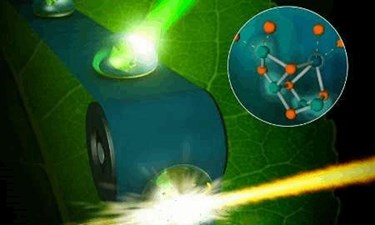Want To Colonize Space? You're Going To Need Artificial Photosynthesis

By John Oncea, Editor

When humans colonize space, where will we start: Mars, Earth’s Moon, or another celestial body? And what should be done on that body: residences, industrialization, or another purpose? Regardless of where we start and for what purpose, space colonization will require a plethora of technologies, including artificial photosynthesis.
“Let us create vessels and sails adjusted to the heavenly ether, and there will be plenty of people unafraid of the empty wastes. In the meantime, we shall prepare, for the brave sky-travelers, maps of the celestial bodies.” – Johannes Kepler, from a letter written to Galileo
“Space; It seems to go on and on forever ... but then you get to the end and a gorilla starts throwing barrels at you.” – Philip J. Fry, Futurama Season 1 Episode 1, Space Pilot 3000
For centuries, people have envisioned transforming the Martian climate into a habitable environment for humans. Carl Sagan was the first to propose terraforming Mars when, in 1971, he suggested vaporizing the northern polar ice caps, which would result in an atmospheric boost, increased global temperatures due to the greenhouse effect, and a higher probability of liquid water on the planet.
To realize Sagan’s vision, technologies new and old are going to be needed. Jumpstart writes that ethylene-emitting cyanobacteria, MOXIE, nuclear thermal propulsion, and fuel-generating microbes are just some of the technologies that have been developed or are currently being developed that will help make life on Mars possible.
They also single out silica aerogel, “a porous, lightweight translucent material used for high-temperature insulation. Its insulating properties are so potent that, in 2019, researchers from Harvard University and NASA’s Jet Propulsion Lab found that silica aerogel could mimic the greenhouse effect on Mars.”
Currently, Mars is uninhabitable due to its low temperatures and high levels of ultraviolet radiation. However, researchers have proposed using a 2-3 cm thick silica aerogel layer to help transmit sufficient light for photosynthesis, block out harmful radiation, and increase temperatures above the melting point of water.
“Unlike the previous ideas to make Mars habitable, this is something that can be developed and tested systematically with materials and technology we already have,” said Robin Wordsworth, Assistant Professor at the Harvard John A Paulson School of Engineering and Applied Sciences (SEAS).
Laura Kerber, Research Scientist at NASA’s Jet Propulsion Laboratory added, “Mars is the most habitable planet in our Solar System besides Earth. But it remains a hostile world for many kinds of life. A system for creating small islands of habitability would allow us to transform Mars in a controlled and scalable way.”
Another Way To Create Photosynthesis
Fact: Humans need oxygen.
Fact: Photosynthesis – a 2.3-billion-year-old process – is a reaction that enables plants and other organisms to harvest sunlight, water, and carbon dioxide while converting them into oxygen.
Fact: “The human need for oxygen makes space travel tricky,” writes Phys.org. “Fuel constraints limit the amount of oxygen we can carry with us, particularly if we want to do long-haul journeys to the Moon and Mars. A one-way trip to Mars usually takes on the order of two years, meaning we can't easily send supplies of resources from Earth.”
Solution: The International Space Station (ISS) produces most of its oxygen by recycling carbon dioxide through electrolysis, a process that splits water into hydrogen gas and oxygen gas using electricity from the station’s solar panels. Additionally, there is a separate system that converts the carbon dioxide that astronauts breathe out into water and methane.
However, these technologies have some drawbacks, as they are unreliable, inefficient, heavy, and difficult to maintain. For example, the oxygen generation process requires about one-third of the total energy needed to run ISS's entire system supporting environmental control and life support.
As a result, researchers a seeking alternative systems not only for ISS but for future trips to the Moon and Mars. “One possibility,” Phys.org writes, “is to harvest solar energy (which is abundant in space) and directly use it for oxygen production and carbon dioxide recycling in only one device.
“The only other input in such a device would be water – similar to the photosynthesis process going on in nature. That would circumvent complex set-ups where the two processes of light harvesting and chemical production are separated, such as on the ISS.”
This solution not only reduces the system’s weight and volume, but it would also increase efficiency. “We could use additional thermal (heat) energy released during the process of capturing solar energy directly for catalyzing (igniting) the chemical reactions – thereby speeding them up. Moreover, complex wiring and maintenance could be significantly reduced.”
A theoretical framework produced to analyze and predict the performance of this artificial photosynthesis found instead of chlorophyll, these devices use semiconductor materials that can be coated directly with simple metallic catalysts supporting the desired chemical reaction.
“Our analysis shows that these devices would indeed be viable to complement existing life support technologies, such as the oxygen generator assembly employed on the ISS. This is particularly the case when combined with devices that concentrate solar energy to power the reactions (essentially large mirrors which focus the incoming sunlight).”
We are lucky to have plants and algae to generate oxygen. However, utilizing artificial photosynthesis devices would enable us to produce hydrogen or carbon-based fuels, rather than just sugars. This could lead to a more sustainable approach to producing energy-rich chemicals, which we can store and use for transportation. The long-term objectives of space exploration and our energy economy are both focused on sustainability. Artificial photosynthesis devices could play a crucial role in achieving this goal.
